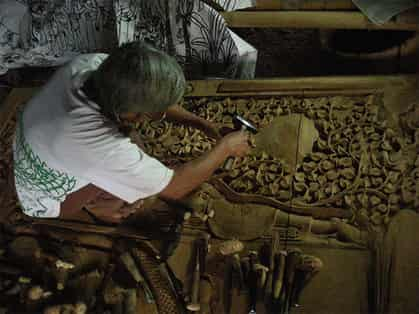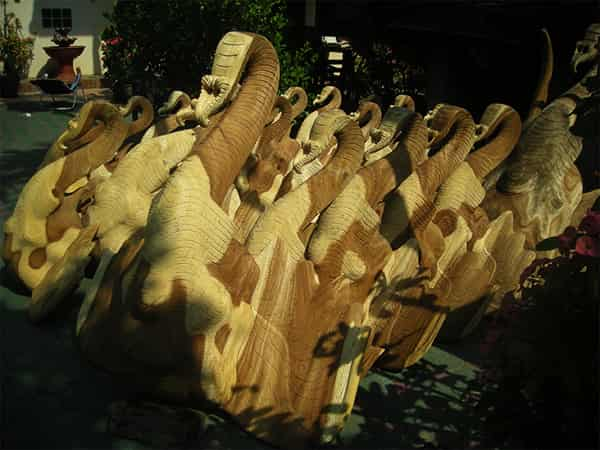
The hills and mountains of the Kingdom of Lanna were once rich in the mighty teak tree and a culture evolved of great skill in carving and working it. The accomplished work of carver monks can be seen at several local temples. The work of Phra Bun Prasert at Wat Buppharam, near the centre of Chiangmai, is an example worth seeing. Detailed scenes from Buddhist scriptures cover the window shutters and hefty doors. They are devotional works of art with passion and reverence.
These skills have been passed down through centuries and a new generation of local carvers is now producing unique work in this tradition which finds markets worldwide. I was fortunate enough to have experienced an insight into the Lanna style of carving via a three day residential carving course in the village of Baan Tawai.
Teak is amongst the world’s great timbers standing alongside mahogany and oak. Big teak sailing ships until not many decades ago still worked Asian sea trade routes as they had for thousands of years. Any quality boat-builder in the world will, to this day, favour the durability and rich copper tones of teak. Yet it can be carved into the finest of detail, creating the most delicate of images. Small wonder that swivel-eyed colonial traders, once swarming over this part of the world, went to extraordinary lengths to grab cargoes of this precious commodity. Read the history of the Burmese teak trade and hang your head in shame farang. I’m hanging mine. I recently inherited a stout old teak chest, whose origins I know little about and which sits in my English workshop awaiting the final stages of restoration. Scars and dents in the timber are evidence that it travelled some miles over some time, but it has years left in it and it is a handsome piece.

Thailand was a little shrewder about keeping at bay these timber barons snapping greedily at the border like bloodhounds. Yet, sadly, because of recent industrialised furniture production, the forests rapidly depleted. Thailand has now taken the wise step of banning teak felling. The King has initiated a programme of “Aggressive Re-forestation” by appropriating unused land for teak plantations. There is talk of rogue loggers still out there. One can see around the region monks’ robes tied around a mature teak tree to offer some protection from such greed – and hope it works.
As a carpenter of some decades experience, I have admired and written about woodwork in several parts of the world and noted that cultures have grown and thrived on the strength of a particular species of tree. In northern Europe it’s the oak. The Pacific, it is said, may not have been settled were it not for the 161 uses of the coconut palm. In the Himalayan foothills the giant Deodar provides shelter and warmth against tough elements: even light – the timber is so resinous you can light it with a match and it will flare for a long time. So it is with Thailand and teak. Teak Buddhas oversee the comings and goings of the faithful over centuries: teak boats have provided transport and homes on the great rivers surviving time and storm. Looking around Chiang Mai amongst the modern concrete buildings there stand the old ones: the teak houses and mansions that are very much the look of old Siam. They are beautifully built and stand the test of time. Sun, rain and termite deplete the strength of many lesser timbers in very few years. But these teak houses, maybe a little dusty, but their ornate tracery on gable and eave, the detailed architrave and ballustrading are still intact, as good as when they were built a century or more ago. This is testament to both the timber and the craftsmen who understood the techniques of how to cast off the rain and yet make carpentry an art-form.

Baan Tawai
Suitably impressed with Thai woodwork I was delighted to find online the offer of local carving lessons. Noppaddol Kamlae, based in Baan Tawai, was trained to carve by an uncle about 35 years ago. His background in the Lanna tradition gives him the ability to undertake most styles. He has tackled European heraldic work. A three metre high oak Buddha he carved insitu stands in Munich’s international sculpture park and he receives international commissions for major pieces of work. His school, on the peaceful outskirts of the village is successful. Experienced carvers come from many countries to glean techniques from a Thai master carver. Bed and board is included in the course as is a thirty-piece set of handmade chisels and gouges. The blades are blacksmith made from recycled railway line. Used car springs are also used, having a suitable quality of steel which, until recently, has been difficult to acquire. The handles are sticks from a particular bush, often with the bark still on, utilised for its resistance to splitting. They are a piece of craftsmanship in themselves and the carvers I met that create such masterpieces staywith these pre-industrial tools despite Nopphadol, at least, having access to modern precision ground carbon steel tools on his visits to German.

I was familiar with the initial stages – chasing the outline with a fine Vee shaped parting tool then cutting the background to expose the shape of my elephants in relief. The learning in earnest began on the shaping. Any Thai carver will have carved elephants by the thousand. There are stylised techniques for portraying the bone structure, the eyes, the ears and the feet that a novice will spend many hours of trial and error to attempt but my teacher demonstrated it in minutes. The leading father elephant took shape. I attempted Mother and spent hours at it. She looked like a soppy cartoon; scrappy round the edges.Ok she had a trunk and all the basics, you could just about tell she wasn’t a pig. Nopphadol takes the view that his students should go away with something worthwhile so a few swift blows and my hours of work were a pile of splinters on the bench. I began to pick up on things. Get the big cuts out of the way, decisively with positive assured strokes rather than picking at it timidly. There were ways with mallet and gouge that the tradesman in me began to appreciate.

It was a great experience to watch him at work. His concentration was absolute – the relationship of hand and eye with the creative part of the brain overseeing is something I can identify with. It is an instinctive action from years of practice. The works that were casually nailed to posts in the workshop – things he had made earlier – were as fine as anything to be seen at the markets. At one point I confess, in a dejected moment, I thought ‘OK mate, let’s see you hang an expensive oak door tidily in a crooked building but I quickly subdued such childishness.
A great part of the experience was that when the market closed in the evening the tourist buses departed and I appeared to be the only farang in town. There are no hotels or restaurants – I did locate a friendly beer wholesaler – which I appreciated. Later I walked out along the canal path to the paddy fields and there in stereo was Thailand’s fabulous soundtrack of frogs and night insects, thrumming with life – like Lanna carvings.
